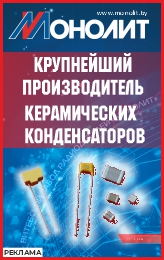Optical Properties of AlN/ GaN Based Heterostructure
DOI: 10.22184/1993-7296.2018.12.7.680.683
Epitaxial integration of the heterostructure allows to increase the differential quantum efficiency of the LED in proportion to the number of radiating regions, to ensure parallelism of radiation beams, to significantly reduce the distance between the radiating regions, to reduce the sequential resistance of devices [6–8]. Along with the listed advantages, this approach has a significant limitation. It consists in increased heat emission of several closely located radiating regions in comparison with traditional devices with one radiating region.
In this work, we determined the optical properties of a multilayer heterostructure based on wide-gap AlN / GaN semiconductors. The purpose of the study is to create a device emitting several wavelengths, the combination of which may allow an increase in the differential quantum efficiency of a LED in the ultraviolet region of the spectrum. A schematically investigated heterostructure is shown in Fig. 1. On an AlN substrate, by the method of molecular beam epitaxy, layers of GaN and AlN are sequentially formed. The result is a symmetric structure consisting of three wells separated by AlN barriers. The thickness of the barrier layers is 1.8 nm. The thickness of the GaN layers is 2.1; 4.2; 2.1 nm, respectively.
The initial data (effective masses of carriers, the width of the energy gap of materials, etc.) for calculations were taken from the thematic database of the A. F. Ioffe Institute [9]. The calculations took into account that, in the AlN / GaN system, the conduction band gap is about 2 eV, and the valence band gap is about 0.7 eV.
As can be seen from Fig. 1, the potential energy profile changes along the coordinate perpendicular to the surface of the structure. We divide the concerned range of coordinates into small intervals, within which we will consider the potential constant. The wave function of the electron is expressed in the form of a superposition of plane waves propagating in opposite directions:
,
where is the electron wave vector.
The amplitudes of the incident A1 and reflected B1 waves of the first layer are taken as +1 and –1, respectively, and we calculate the amplitudes in all subsequent layers using the transfer matrix. As a result, one can obtain an equation for the electron wave function at the output of the structure, from which one can calculate the values of the energy of quantization levels in quantum wells. Figure 2 shows the dependence of the square of the modulus of the electron wave function on the coordinate for the heterostructure shown in Fig. 1.
Calculations show that the energy of the first four levels of quantization of a structure is a complex value and has the following values:
Е1 = 0,214 – 1,201 · 10–11 i;
Е2 = 0,306 + 2,124 · 10–12 i;
Е3 = 0,693 – 4,188 · 10–12 i;
Е1 = 1,235 + 1,935 · 10–20 i.
The countdown is from the bottom of the pit. From Fig. 2, it is seen that particles with energies corresponding to quantization levels are localized in the central well. The square of the module of the imaginary part of the energy of the quantization level is proportional to the carrier concentration at this level. Based on the calculated energy values, the relative carrier concentrations were estimated at the corresponding quantization levels. Calculations show that in the structure, 3 and 4 energy levels in the pit will be predominantly populated by electrons.
Similar calculations were performed for the case of the motion of holes in the valence band of this structure. In this case, hole localization is also observed in the region of the central well, and the energies of the first four quantization levels have the following meanings:
Е1 = 0,018 – 8,320 · 10–13 i;
Е2 = 0,015 – 1,901 · 10–14 i;
Е3 = 0,168 + 1,268 · 10–12 i;
Е1 = 0,307 + 2,849 · 10–11 i.
The countdown is done from bottom of the pit. The calculation of the relative carrier concentration at the levels shows that the holes mainly populate the first and second quantization levels.
Next, the photon energy was calculated for the recombination of electrons and holes in the region of the central pit of the structure. The calculated values of the energy levels in the conduction and valence bands, as well as the radiation wavelengths at possible optical transitions are shown in Fig. 3.
Thus, the calculations show that the proposed structure is a potential source of radiation in the vicinity of 278 and 317 nm and can be used in the formation of high-performance light-emitting devices in the ultraviolet range.

 rus
rus TS_pub
TS_pub technospheramag
technospheramag technospheramag
technospheramag ТЕХНОСФЕРА_РИЦ
ТЕХНОСФЕРА_РИЦ


